Fairy tales, folk tales, and mythology have been around for centuries, passed down through generations as a way to teach morals, values, and lessons. While these stories may have had good intentions, the tropes and stereotypes within them can be problematic, especially when it comes to female characters.
In traditional fairy tales, women are often portrayed as weak, helpless, and in need of rescue from a man. These stories reinforce patriarchal values and reinforce gender roles that can be damaging to young girls' self-esteem and self-worth. It's time for a change, and contemporary painting can play a significant role in reinterpreting these stories for the 21st century.
Through contemporary painting, we can reimagine these stories with a modern twist, exploring themes of empowerment, independence, and self-discovery. By subverting traditional gender roles, we can challenge the patriarchal narrative and create new stories that inspire and uplift women.
Contemporary painters have already begun to reinterpret fairy tales and mythology in exciting ways. For example, artists like Kara Walker and Cindy Sherman use fairy tale motifs to challenge gender roles and stereotypes in their work. Walker's paper-cut silhouettes address issues of race, gender, and power through her depictions of traditional fairy tales, while Sherman's photography examines the ways in which women are portrayed in art and media.
Other contemporary painters, like Kiki Smith and Wangechi Mutu, use fairy tales and mythology to explore female experiences and issues. Smith's work often addresses themes of mortality and the body, while Mutu's collages examine issues of identity, race, and gender.
By reimagining fairy tales, folk tales, and mythology, contemporary painters can create a new narrative that speaks to the experiences and challenges of women in the 21st century. Through their work, they can inspire and empower women, challenging traditional gender roles and stereotypes and creating a new vision for what it means to be a strong, independent woman.
In conclusion, contemporary painting offers a powerful tool for reinterpreting fairy tales, folk tales, and mythology in a way that empowers women and challenges traditional gender roles. By subverting the tropes and stereotypes of traditional stories, contemporary painters can create new narratives that reflect the experiences and challenges of women in the 21st century, inspiring and uplifting audiences everywhere.



